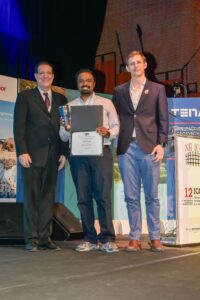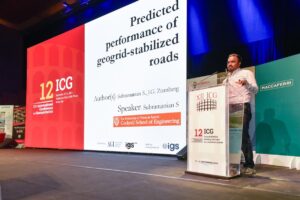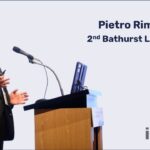 An e-bike is on the shopping list after Subramanian Sankaranarayanan, also known as Subu, won the Best Young Member Paper prize at the 12th International Conference on Geosynthetics (12th ICG). Here, he shares details about his award-winning paper on pavement stability using geogrids and why he values being an IGS Young Member.
An e-bike is on the shopping list after Subramanian Sankaranarayanan, also known as Subu, won the Best Young Member Paper prize at the 12th International Conference on Geosynthetics (12th ICG). Here, he shares details about his award-winning paper on pavement stability using geogrids and why he values being an IGS Young Member.
Congratulations Subu, how does it feel to win the IGS Young Paper contest?
It’s an incredible feeling. The recognition is not just for me, but for all the people who have supported and guided me throughout my research journey. It shows that our research has made a significant impact and is recognized by our peers, which is incredibly rewarding and inspires us to continue to push the boundaries of knowledge in geosynthetics.
This is my first award for a paper, and I am very happy it was at the ICG. My research could not have found a more relevant conference, which makes this recognition even more meaningful and inspiring.
Tell us a bit about your background.
I am from the city of Tirunelveli in India, where my mom was a civil engineer at the state water supply department (TWAD). She inspired me to pursue a career in civil engineering, and my journey brought me to the United States, where I joined the PhD program at the University of Texas at Austin. Under Professor Jorge Zornberg, I specialized in geosynthetic-stabilization of unbound aggregate base courses in flexible pavements.
After completing my PhD, I joined the Transtec Group, a pavement engineering firm based in Austin, where I work on Intelligent Construction Technologies.
What was your award-winning paper about and why this topic?
My paper focused on predicting the benefits (in terms of Traffic Benefit Ratio, or TBR) of including a geosynthetic in the base layer of a flexible pavement. I chose this topic because geosynthetics have been used since the 1980s to enhance the performance of roads. However, despite their advantages, the adoption rate of geogrids for base stabilization in new pavement projects has been low. This is mainly due to an incomplete understanding of how geogrid-stabilization works and what properties are significant in design.
By writing this paper, I hoped to increase understanding and confidence in the use of geogrids. Identifying the significant properties in stabilized road-base design will increase confidence in the adoption of novel geogrid products in new pavement projects and the development of novel geogrid products best suited for base stabilization applications.
In essence, my paper aimed to bridge the gap between theory and practice, paving the way for more efficient and sustainable road construction.
What was it like presenting your paper live to the 12th ICG conference?
I was excited but definitely anxious that it was going to be in front of the judges. But the moment I got up on stage and started talking, the familiarity with the material helped me carry the presentation with confidence. There were a couple of questions at the end: one was on defining TBR (I had used the word in one of my slides), the second was on how my work (laboratory test) translated to the real world, which gave me an opportunity to emphasize the potential applications of my work.


What were your other conference highlights?
My wife and I found the Welcome Concert on Sunday evening to be mesmerizing – we never expected that exceptional a performance at a geosynthetics conference.
Also, the Bathurst Lecture by Dr. Yoshihisa Miyata was a very interesting recap, update, and path forward about MSE walls. The philosophical aspects Dr. Miyata raised such as how long should a structure be designed to last, the sustainability concerns, and lifecycle costs, were thought-provoking. To have distilled about 700 papers on this topic in the last five decades, easily made this my conference highlight.
I also enjoyed the special session on ‘Design methods for basal reinforcement of embankments’, especially the presentation about the German standard EBGEO by Dr. Dimiter Alexiew. The historical background under which this standard was developed (the fall of the Berlin wall and immediate need for better highway infrastructure to reunite west and east Germany) was very interesting.
What do you enjoy doing outside work?
I love to hike and cycle around the green spaces in the city and sometimes at state/national parks outside Austin. The outdoor exercise and greenery definitely improve my mental health as well as physical health, sometimes even helping to see my research problems from a different perspective.
Why did you become an IGS Young Member? What do you enjoy about it?
An IGS membership is huge value, especially for me as a young researcher out of academia whose primary area of research is in geosynthetics. It is a great platform to network with industry experts, but also keep up with the latest research and publications. As someone who recently graduated and joined the industry, I no longer have university access to journals, but the IGS Digital Library allows me to stay up-to-date with anything related to geosynthetics, and that is a boon.
What will you spend your $1,000 prize money on?
I have been eyeing an e-bike for the longest time. I will be putting the prize money towards that.
What are your plans for the future?
I’m excited about the future and look forward to making significant contributions to the field of geosynthetics and pavement engineering.
To find out more about becoming an IGS Young Member, visit here.





















